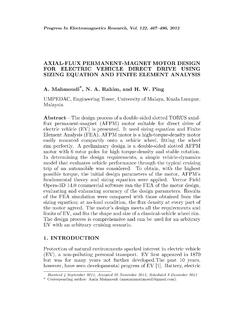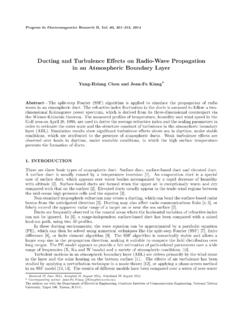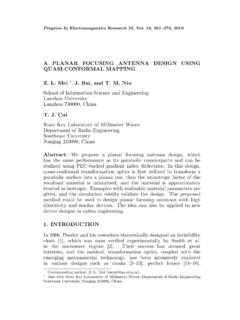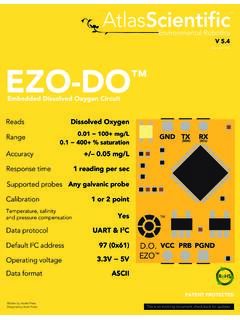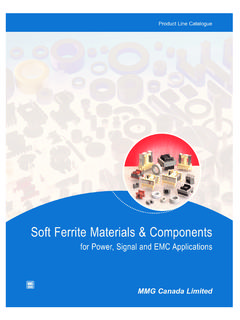Transcription of CHARACTERIZATIONOFTHEOPEN-ENDED ...
1 Progress In Electromagnetics Research, PIER 60, 311 333, 2006. CHARACTERIZATION OF THE OPEN-ENDED. COAXIAL PROBE USED FOR NEAR-FIELD. MEASUREMENTS IN EMC APPLICATIONS. D. Baudry, A. Louis, and B. Mazari IRSEEM. Technop ole du Madrillet, Avenue Galil ee BP 10024. 76801 Saint Etienne du Rouvray Cedex, France Abstract A completely automatically near- eld mapping system is developed within IRSEEM (Research Institute for Electronic Embedded Systems) in order to determine electromagnetic eld radiated by electronic systems. This test bench uses a 3D positioning system of the probe to make accurate measurements. The main element of this measurement tool is the probe. This paper presents a characterization of the open-ended coaxial probe which is used to measure the normal component of the electric eld. 1. INTRODUCTION. Nowadays, electronic systems are integrating more and more functionalities in a con ned volume; however, some components generate electromagnetic interference (EMI) problems.
2 The complexity of these devices can reduce the e ciency of each function. The knowledge of the electromagnetic environment is therefore essential. Traditional measurement systems which use network analyzers or classical simulation tools do not enable us to determine the electromagnetic near eld which is close to complex and especially active devices. It is therefore necessary to use near- eld measurements to characterize EMI problems. The use of Near- eld techniques in EMC applications increases rapidly. These techniques are used to characterize a complete system [1] but also to locate the emission sources inside a component [2, 3]. To reach this objective, the near- eld test bench and especially the performances of the used probes must be well known. IRSEEM (Research Institute for Electronic Embedded Systems). is developing a near- eld test bench to carry out these measurements.
3 312 Baudry, Louis, and Mazari this equipment collects the electromagnetic eld close to devices of various sizes. Di erent passive planar circuits [4] and active devices [5] validated the ability of the bench for measuring relative amplitude of all the electromagnetic eld components. E ective measurements of radiated emissions need the calibration of the probe. An understanding of coupling mechanism is necessary for choosing an appropriate calibration method for near eld measurement probe. This paper presents a characterization of the coaxial probe and a calibration technique [6]. In the last part, absolute amplitude and phase measurements of a hybrid junction are presented. 2. EXPERIMENTAL SETUP. The system is based on a direct measurement method [7, 8]. The probe is connected to a spectrum analyzer and is mounted on a ve-axis robot. A computer monitors the probe displacement over the device under test (DUT) and acquires data provided by the spectrum analyzer (Fig.)
4 1). The maximum scanning area is 200 cm(x) 100 cm(y) . 60 cm(z) with a mechanical resolution by 10 m in the three directions (x, y and z) and for the two rotations. Spectrum analyser Computer z y Probe y DUT x Figure 1. Synoptic of the test bench. The probe must be close to the surface of the components in order to ensure a good resolution of measurements. A 3D positioning system based on relief measurements allows maintaining a constant distance between the probe and the device. The method used to acquire the Progress In Electromagnetics Research, PIER 60, 2006 313. relief model of objects is based on laser triangulation. The object is illuminated from one direction with a laser line projector and viewed with the camera from another one. Laser and camera are held on the robot (Fig. 2). Translating the positioning system along the x axis of the robot enables to acquire the relief model of the device under test.
5 Camera-provided Z data are recorded on a computer and converted into probe coordinates. Finally, these data are used to position the probe over the device under test during electromagnetic measurements. Figure 2. 3D positioning system. Measurements of all the components of the electromagnetic eld are achieved with three di erent probes (Fig. 3). The rst probe [9] is used to measure the three components of the magnetic eld. It consists of a small loop made with inner conductor of two adjacent coaxial cables. The probe measures the magnetic eld that is perpendicular to the loop. The three components of the magnetic eld are obtained by rotating the probe with an angle of 90 around the three x, y and z directions. The second probe is a balanced wire dipole that consists of two adjacent coaxial cables and a hybrid 180 junction to balance the dipole [10].
6 This dipole is used to measure the tangential components of the electric eld (Ex and Ey ). A spectrum analyzer measures the di erence between the two signals of the junction output ports. Ex and Ey components of the electric eld are measured by rotating the probe with an angle of 90 around z axes. The last probe (EPZ1) used to measure the normal component of the electric eld (Ez ) consists of a 50 open-end coaxial cable oriented in a parallel direction to this eld. This probe has an inner conductor diameter of 500 m. Next 314 Baudry, Louis, and Mazari parts of this work are only focused on this last probe. loop dipole Magnetic probe Electric probes Figure 3. Magnetic and electric probes. 3. VALIDATION OF THE TEST BENCH. In order to validate the test bench, a simple passive circuit is measured and experimental results are compared with simulated ones.
7 All simulations are made with Ansoft HFSS a commercial 3D. electromagnetic simulator based on Finite Element Method (FEM). The sample circuit tested is a 50 micro-strip line at a frequency of 1 GHz. The line has a length of (wavelength of radiation). Substrate's thickness and relative permittivity are respectively mm and The measurements are implemented for three distances d between the probe and the DUT: 1, 2 and 5 mm. The micro-strip line is oriented along the x axis and the centre of the line is at y = 0 mm. Complete cartographies of the micro-strip line in short circuit and open circuit are presented on Fig. 4. We can see that eld's maximum is located on the center of the line as expected by the theory. Measurements show also the standing wave patterns with a period of /2 and a shift of /4 between short circuit and open circuit. The probe resolution enables detecting eld minima on the edges of micro-strip line.
8 Next we compared experimental results with simulated ones. Results are presented Fig. 5 with measurement on the left side and simulation on the right side. In the absence of calibration, a translation factor is applied to simulation in order to put maxima at the same level. We can note a quite good accordance between measurement and Progress In Electromagnetics Research, PIER 60, 2006 315. Short circuit Open circuit 20 20. d=1mm 10 10. y (mm). y (mm). 0 0. 0 50 100 150 0 50 100 150. x (mm) x (mm). 20 20. d=2mm 10 10. y (mm). y (mm). P (dBm). 0 0. 0 50 100 150 0 50 100 150. x (mm) x (mm). 20 20. d=5mm 10 10. y (mm). y (mm). 0 0. 0 50 100 150 0 50 100 150. x (mm) x (mm). Figure 4. Measurement of normal electric eld at selected height above micro-strip line. Measurement Simulation -40 -40. -60 -60. -80 -80. Ez (dBV/m). -50 150 -50 150. P (dBm). -100 -100.
9 -100 100 -100 100. 20 50 -120 20 50 -120. 0 x (mm) 0 x (mm). y (mm) -20 0 y (mm) -20 0. Figure 5. Mapping of the normal component of the electric eld. simulation. The main di erences are secondary peaks not present on the measurement and a greater distance between minima. This rst measurement on a micro-strip line shows that the coaxial probe mainly detects the normal component of the electric eld but di erences exist between measurement and simulation. In a second 316 Baudry, Louis, and Mazari step, we make a parametric study of this probe to understand these di erences and to characterize the probe. 4. STUDY OF THE OPEN-ENDED COAXIAL PROBE. Simulation of the Global System We simulate the complete system probe and micro-strip line in order to verify that di erences between measurement and simulation are due to the transfer function of the probe. The probe is moved during the simulation along a transverse line (y axis) and the transmitted power (S31 ) is calculated between one port of the line and the port of the probe.
10 For both simulation and measurement the micro-strip line is loaded by an impedance of 50 . The results we obtained are shown on Fig. 6. The simulation of the normal component of the electric eld (Ez ) is also plotted on this graph. The good accordance between measurement and simulation con rms that di erences between measurement and theory are not due to outer disturbance of the test bench, but de nitely to results of an electromagnetic eld coupling with the outer conductor of the coaxial probe. 50. measurement EPZ1. simulation EPZ1. 55 Ez 60. 65. Power (dBm) or Ez(dBV/m). 70. 75. 80. 85. 90. 95. 100. 20 15 10 5 0 5 10 15 20. y (mm). Figure 6. Measurement and simulation of a cross section at 1 mm over the micro-strip line. Progress In Electromagnetics Research, PIER 60, 2006 317. In uent Parameters and Criteria of Comparison The studied geometrical parameters of the coaxial probe are represented on Fig.
